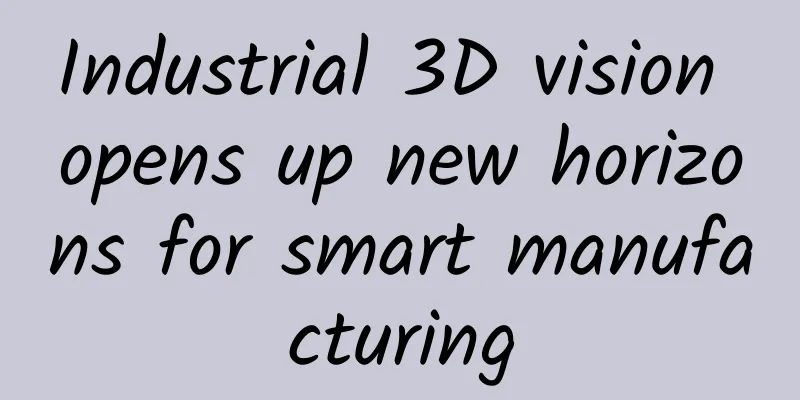Industrial 3D vision opens up new horizons for smart manufacturing

|
In 1969, the first CCD image sensor was born in Bell Labs in the United States, opening the door to digital imaging for the industrial vision industry. Since then, all areas of life and production have begun to be connected with images and vision. The field of machine vision has also begun to sprout and grow: from black and white to color, from low resolution to high resolution, from static images to dynamic images. Today, we have made it possible for machines to understand the three-dimensional space of reality and present three-dimensional images in front of our eyes, which is what industry insiders call the fourth visual revolution. The key to the visual dimension upgrade of the fourth visual revolution is the rapid development of the 3D sensing industry. Machine vision has evolved from 2D plane to 3D stereoscopic "horizon". The key technology behind the commonly used products and technologies such as face payment, Face ID, VR, unmanned convenience stores, and smart robots is 3D vision technology. The combination of the fourth visual revolution and the industrial Internet has also maximized the value of the real economy and technology, and has gradually moved towards real industrial scenarios, production efficiency, and industrial feasibility. If we use one sentence to describe the relationship between the Industrial Internet and 3D machine vision, the most appropriate description is this sentence: The future of the Industrial Internet is based on 3D machine vision control and AI cognitive system processing. The application of machine vision in the industrial field is nothing new, and it has been developed for more than 30 years. With the rise of industrial 3D vision technology, its weight in the industrial manufacturing field is also increasing. From a single scenario to empowering the entire production line Industrial vision technology was the first 2D vision technology used in automated production. However, since 2D vision can usually only solve problems on a plane, it is difficult for 2D vision to work for objects with high information, such as products involving curved surfaces and curvatures. This has promoted the rise of 3D vision. Compared with 2D vision, 3D vision is insensitive to changes in ambient light, has higher accuracy and reliability, and can detect fast-moving targets in the production line and obtain information such as shape, color contrast, and spatial coordinates. 3D vision can meet more industrial scene applications that were difficult to meet with 2D vision in the past, and complements 2D vision. Coupled with the continuous improvement in precision requirements for precision in precision manufacturing industries such as consumer electronics, automobiles, and semiconductors in recent years, high-precision 3D vision technology has become a hot spot in the market. Industrial 3D vision is mainly concentrated in three categories of applications: size and defect detection, intelligent manufacturing, and autonomous navigation. The biggest change in the use of industrial 3D vision technology in the industrial field in the past two years is that it has developed from a single scene such as quality inspection to empowering the entire production line. On the production line, before the introduction of industrial 3D vision, it was only used in a single scenario, such as the most widely used quality inspection. Take the production process of smartphones as an example. The links involving size and defect detection are mainly in the three parts of the motherboard, component assembly, and packaging and shipment. Then the industrial 3D vision system for quality inspection is also mainly involved in these three processes. Now, with the integration of industrial 3D vision systems, the entire production line from material loading production to packaging inspection can be applied across links and scenarios. For example, scenes such as loading and unloading of production lines and welding, spraying, and assembly of components can all be applied to industrial 3D vision systems. As for the current popular flexible manufacturing needs, the production environment under flexible manufacturing is more complex, and the demand for intelligent operation is higher. Under the flexible production mode, industrial robots and automation equipment need to flexibly change according to production needs to produce a variety of product models. In the loading and unloading, sorting, and handling links, they need to plan and complete the operation tasks in real time according to the different product types. Traditional industrial robots or automation equipment cannot achieve this at all, and the introduction of industrial 3D vision systems makes the flexible production model smoother. Only by jumping out of the traditional small set of automation solutions and realizing truly fully compatible intelligent operations can this usage demand be met. This is a typical demand for flexible production for intelligent vision systems. For example, in smart logistics, the flexibility improvement brought by 3D vision algorithms can achieve accurate identification and sorting of massive SKUs of goods through "AI+3D vision". In particular, the interaction between visual recognition and robot trajectory planning, grasping, movement and other controls can break through the bottleneck of smart logistics growth and greatly expand the boundaries of customer coverage. Of course, the application of 2D vision system technology has not been completely eliminated in the field of industrial manufacturing. 3D vision system technology will also serve as a supplement to 2D technology. This hybrid solution will also be used in the measurement of components, such as checking the size and position of the SIM card slot, battery module, and camera module on the mobile phone. Most manufacturers will provide 2D/3D hybrid solutions. Whether it is a single-scenario application or a cross-link or multi-technical solution, 3D machine vision has played an important role in the field of industrial manufacturing. However, in terms of the research and development of core components required for high-precision detection, there is still a large gap in technology compared with foreign countries, which is difficult to surpass in a short period of time. Obstacles of “blurring” industrial 3D visual field In fact, the development of industrial-grade 3D vision technology both at home and abroad started around 2014. With the continuous migration and upgrading of the industrial chain in China, domestic R&D companies have gradually increased their investment in 3D vision technology. However, when it comes to the implementation in the industrial field, due to the wide variety of industries, technical barriers and different scenarios, most manufacturers basically enter from a certain vertical field. The hardware technology capabilities related to 3D vision are limited, and the rising AI algorithm strength can meet some high-precision detection needs, which makes up for the lack of hardware to a certain extent, but there are many problems that need to be solved on the road to the development of industrial 3D vision. 1. Technology and products need to be continuously upgraded. Industrial 3D machine vision imaging technology continues to develop, but the bottleneck technology in the underlying visual hardware equipment is chips and optical lenses, which are still dominated by foreign manufacturers. Integrated 3D machine vision currently does not have a 3D sensor that has the advantages of strong resistance to ambient light interference, high ranging accuracy, high resolution and low cost. At present, the application of 3D vision still selects cameras based on specific usage scenarios and budgets, and then customizes and develops algorithms based on the camera imaging results. This high-cost and long-term application model severely limits the use of 3D vision in actual scenarios. 2. Difficulty in balancing costs and market cultivation. In the 3D vision market, participating manufacturers are all engaged in price involution, whether for the purpose of obtaining good-looking data for financing in the later stage or for seizing the market. Although the price war indirectly cultivates the market, it also damages the market order, and the user experience at low prices cannot be guaranteed. However, for potential seed users, one of the difficulties affecting their automation transformation is cost considerations. If the cost exceeds their budget, market cultivation cannot be carried out. At present, the market penetration rate of industrial 3D vision is not high. 3. The immaturity and imperfection of the market and supply chain. For some manufacturers who need to purchase 3D vision products, the initial product volume demand is relatively small. In this case, industrial 3D vision manufacturers cannot spread product costs through scale, and a large number of potential users in the market are price and supply chain sensitive users. It is difficult for industrial 3D vision products in the early stages of development to leverage the market. 4. The adaptation and cycle of production lines are long. The customized production line requirements of thousands of industries make the equipment non-standard and have poor versatility. For factories, different business scenarios, production links, and even different factories have different requirements. The multiple varieties and small batches in the manufacturing process affect the difficulty of enterprise transformation. After the equipment is delivered, it still needs to be debugged for a period of time before it can be adapted to the production line. There is a certain period that affects the enthusiasm of enterprises for automation transformation. From the perspective of customers who select industrial 3D vision products, the user's selection criteria depend on the factory's own characteristics and budget. This means that industrial 3D vision manufacturers must provide attractive prices while providing the ability to adapt products. The costs and budgets of both parties need to be adjusted to a suitable balance. These requirements limit the widespread implementation of 3D vision technology in the field of industrial manufacturing. The large-scale commercial scenarios of industrial 3D vision systems are not mature in the early stages of development, and the products are highly customized. The overall market is scattered and fragmented. 3D vision system technology still needs to continue to climb in this market, explore and develop in each segmented scenario, find differentiation, improve products and enhance the ability to serve the market, so as to enable the upgrade of the future industrial Internet. The future of industrial 3D vision As an important sensing part of industrial production line machinery and equipment, in recent years, in the context of the upgrading and transformation of Industry 4.0, industrial 3D vision technology, as one of the core technology units, has made rapid progress in industrialization. It is currently accelerating its penetration into multiple manufacturing industries, and the scale of the entire industrial chain is also showing an accelerated expansion. GGII data shows that with the widespread application of machine vision technology in the industrial field, my country's machine vision market size is expected to reach 20.86 billion yuan by 2023, of which the 3D vision market size will reach 3.428 billion yuan; my country's 3D vision market size is expected to exceed 10 billion yuan by 2025. As smart manufacturing and precision machining put forward higher requirements for production processes and testing standards, 3D vision systems are also evolving towards a wider range of machine "vision". These changes and requirements have opened up 3D vision applications and accelerated the widespread implementation of 3D machine vision in the manufacturing industry. In the next step, in the process of deep integration of industry and intelligence, these trend changes will also appear. 1. The development trend of industrial 3D vision technology tends to high performance and multiple scenarios. With the continuous iteration of 3D imaging technology, the performance of machine vision technology will also rise and develop in the direction of high performance. This is mainly manifested in the continuous improvement of industrial camera imaging resolution, image acquisition speed and transmission reliability. At the same time, the light source is extended from visible light to non-visible light, and the camera is extended from single spectrum to multiple and high spectrum, expanding the application scenarios of machine vision. 2. Develop towards intelligence and real-time performance. Intelligence mainly relies on new technologies such as cloud computing, big data, and artificial intelligence, and uses technologies such as deep learning to improve the processing and analysis capabilities of industrial 3D vision technology. Intelligence will be one of the core selling points of future industrial 3D vision systems, continuously improving corporate production efficiency and product quality consistency. 5G technology, which is the core development in digital infrastructure, will be combined with industrial 3D vision technology, relying on 5G's large bandwidth, low latency, and high reliability to provide real-time computing and high data security for industrial 3D vision, while reducing the risks caused by network interruptions. 3. Industrial 3D vision systems are developing towards integration and miniaturization. With the continuous improvement of the manufacturing process and optical performance of the core components of industrial 3D vision systems, industrial 3D vision systems will gradually develop towards miniaturization and integration in the future. Optical modules, communication modules and computing modules will continue to be integrated into a single device. Integrated devices also broaden the application areas of machine vision. The innovation of the fourth generation of visual technology has just begun. In the fields of ultra-high precision measurement, domestic enterprises have gradually taken steps, and there is still a lot of room for growth in the future. The fourth visual revolution has endowed the equipment of industrial production lines with a pair of intelligent three-dimensional eyes. With the continuous advancement of hardware equipment technology and the continuous optimization of algorithms and software, machines can not only see the three-dimensional world clearly, but also "understand" the world better. Industrial 3D vision manufacturers will continue to improve their technology systems on the road of upgrading and fighting monsters, so that they can see faster and more clearly. Both the industry and the investment community have given the industrial 3D vision system a positive feedback dimension in this rapidly growing market. More importantly, industrial 3D vision has been continuously iterating in the global competitive landscape, paving a way for China's competitiveness to upgrade. In this vigorous visual revolution, low-cost, high-performance industrial 3D vision system technology will serve as the core of future factory intelligent hardware equipment, support the rapid development of AIOT intelligent hardware, and promote the opening of the industrial Internet of Everything. |
<<: Want to try hanging hula hoop? I advise you to do it within your ability
Recommend
How do small and medium-sized enterprises choose server leasing?
How do small and medium-sized enterprises choose ...
Can Tik Tok short videos be used for SEO?
When it comes to search, the first thing that com...
How does the modern "Kuafu" satellite chase the sun?
Produced by: Science Popularization China Author:...
When doing short video live streaming, how can you obtain real short video industry information?
When making short videos , you often hear two voi...
The reason you are no longer satisfied with your sex life may be just because you are addicted to porn movies
Few things are truly universal. Although people a...
[Summer 2021] Senior 3 English target A+ Quinny
[Summer 2021] Senior 3 English target A+ Quinny 【...
A rare disease is occurring frequently in a French mountain village. Is the culprit behind it actually a delicious dish?
In Montchaven, a ski resort in the French Alps, a...
6 ways to monetize your products!
The ultimate goal of a product is often to realiz...
Training camp operation strategy from 0 to 1 million!
In 2020, I was not satisfied with the status quo ...
The acquitted leopard cat, is it a leopard or a cat?
A cat-sized ocelot appeared in the local news. Th...
Alternative fun: 10 programming language features that confuse programmers
Every language has its own unique features, wheth...
Introduction to home decoration space design
Starting from the basics, we will understand the ...
Marketing promotion review: Behind the screen-sweeping test games of NetEase, Snowball and others!
This article reviews and compares two test games ...
How Amazon ignited the robot arms race
Workplaces at Amazon warehouses are often hectic ...
Four national departments jointly issued a document, stating that these examinations in hospitals will no longer need to be repeated!
Four national departments jointly issued a docume...









